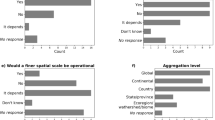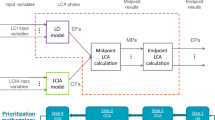Abstract
Purpose
Regional life-cycle assessment (LCA) is gaining an increasing attention among LCA scholars and practitioners. Here, we present a generalized computational structure for regional LCA, discuss in-depth the major challenges facing the field, and point to a direction in which we believe regional LCA should be headed.
Methods
Using an example, we first demonstrate that when there is regional heterogeneity (be it due to environmental conditions or technologies), average data would be inadequate for estimating the life-cycle impacts of a product produced in a specific region or even that of an average product produced in many regions. And when there is such regional heterogeneity, an understanding of how regions are connected through commodity flows is important to the accuracy of regional LCA estimates. Then, we present a generalized computational structure for regional LCA that takes into account interregional commodity flows, can evaluate various cases of regional differentiation, and can account for multiple impact categories simultaneously. In so doing, we show what kinds of data are required for this generalized framework of regional LCA.
Results and discussion
We discuss the major challenges facing regional LCA in terms of data requirements and computational complexity, and their implications for the choice of an optimal regional scale (i.e., the number of regions delineated within the geographic boundary studied).
Conclusions
We strongly recommend scholars from LCI and LCIA to work together and choose a spatial scale that not only adequately captures environmental characteristics but also allows inventory data to be reasonably compiled or estimated.


Similar content being viewed by others
References
Bare J, Norris G, Pennington D, McKone T (2003) The tool for the reduction and assessment of chemical and other environmental impacts. J Ind Ecol 6:49–78
Chiu Y, Walseth B, Suh S (2009) Water embodied in bioethanol in the United States. Environ Sci Technol 43:2688–2692
Du L, Wei C, Cai S (2012) Economic development and carbon dioxide emissions in China: provincial panel data analysis. China Econ Rev 23:371–384
Frischknecht R, Rebitzer G (2005) The ecoinvent database system: a comprehensive web-based LCA database. J Clean Prod 13:1337–1343
Geyer R, Stoms D, Kallaos J (2013) Spatially-explicit life cycle assessment of sun-to-wheels transportation pathways in the US. Environ Sci Technol 47:1170–1176
Heijungs R (2012) Spatial differentiation, GIS-based regionalization, hyperregionalization and the boundaries of LCA. In: Ioppolo G (ed) Environment and energy. Milano, Italy, pp 165–176
Heijungs R, Suh S (2002) The computational structure of life cycle assessment. Kluwer Academic Pub, Dordrecht
Heijungs R, de Koning A, Wegener Sleeswijk A (2015) Sustainability analysis and systems of linear equations in the era of data abundance. J Environ Account Manag 3:109–122
Hellweg S, i Canals LM (2014) Emerging approaches, challenges and opportunities in life cycle assessment. Science 344:1109–1113
Lenzen M, Wachsmann U (2004) Wind turbines in Brazil and Germany: an example of geographical variability in life-cycle assessment. Appl Energy 77:119–130
Miller S, Landis A, Theis T (2006) Use of Monte Carlo analysis to characterize nitrogen fluxes in agroecosystems. Environ Sci Technol 40:2324–2332
Mutel CL, Pfister S, Hellweg S (2011) GIS-based regionalized life cycle assessment: how big is small enough? Methodology and case study of electricity generation. Environ Sci Technol 46:1096–1103
Mutel CL, de Baan L, Hellweg S (2013) Two-step sensitivity testing of parametrized and regionalized life cycle assessments: methodology and case study. Environ Sci Technol 47:5660–5667
Núñez M, Pfister S, Vargas M, Antón A (2015) Spatial and temporal specific characterisation factors for water use impact assessment in Spain. Int J Life Cycle Assess 20:128–138
Potting J, Hauschild M (2006) Spatial differentiation in life cycle impact assessment: a decade of method development to increase the environmental realism of LCIA. Int J Life Cycle Assess 11:11–13
Potting J, Schöpp W, Blok K, Hauschild M (1998) Site‐dependent life‐cycle impact assessment of acidification. J Ind Ecol 2:63–87
Rosenbaum RK, Margni M, Jolliet O (2007) A flexible matrix algebra framework for the multimedia multipathway modeling of emission to impacts. Environ Int 33:624–634
Rosenbaum RK, Bachmann TM, Gold LS et al (2008) USEtox—the UNEP-SETAC toxicity model: recommended characterisation factors for human toxicity and freshwater ecotoxicity in life cycle impact assessment. Int J Life Cycle Assess 13:532–546
Tessum CW, Marshall JD, Hill JD (2012) A spatially and temporally explicit life cycle inventory of air pollutants from gasoline and ethanol in the United States. Environ Sci Technol 46(20):11408–11417
Wegener Sleeswijk A, Heijungs R (2010) GLOBOX: a spatially differentiated global fate, intake and effect model for toxicity assessment in LCA. Sci Total Environ 408:2817–2832
Yang Y (2016) Toward a more accurate regionalized life cycle inventory. J Clean Prod 112:308–315
Yang Y, Suh S (2015) Land cover change from cotton to corn in the USA relieves freshwater ecotoxicity impact but may aggravate other regional environmental impacts. Int J Life Cycle Assess 20:196–203
Yang Y, Bae J, Kim J, Suh S (2012) Replacing gasoline with corn ethanol results in significant environmental problem-shifting. Environ Sci Technol 46:3671–3678
Author information
Authors and Affiliations
Corresponding author
Additional information
Responsible editor: Rolf Frischknecht
Rights and permissions
About this article
Cite this article
Yang, Y., Heijungs, R. A generalized computational structure for regional life-cycle assessment. Int J Life Cycle Assess 22, 213–221 (2017). https://doi.org/10.1007/s11367-016-1155-0
Received:
Accepted:
Published:
Issue Date:
DOI: https://doi.org/10.1007/s11367-016-1155-0




